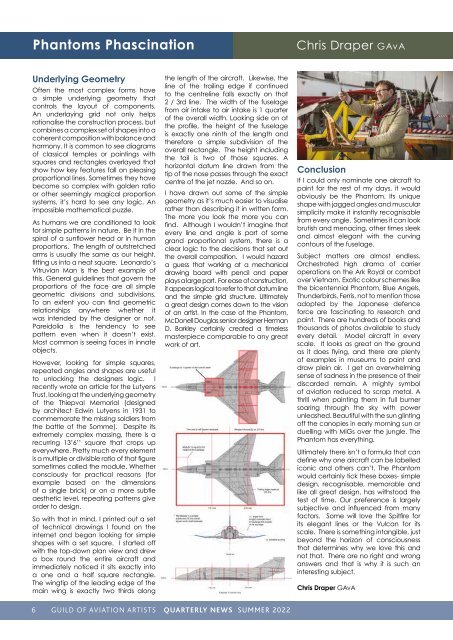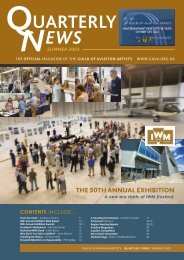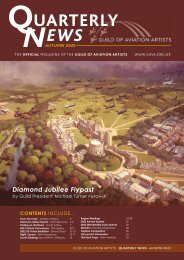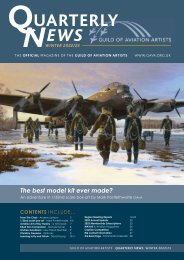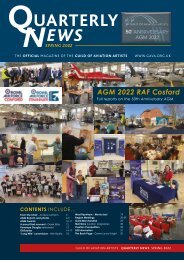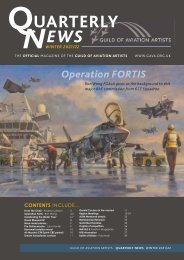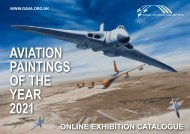QN SUMMER 22
Quarterly News from the Guild of Aviation Artists Summer 2022 edition
Quarterly News from the Guild of Aviation Artists
Summer 2022 edition
Create successful ePaper yourself
Turn your PDF publications into a flip-book with our unique Google optimized e-Paper software.
Phantoms Phascination Chris Draper GAvA British Phantom Aviation Group<br />
Underlying Geometry<br />
Often the most complex forms have<br />
a simple underlying geometry that<br />
controls the layout of components.<br />
An underlaying grid not only helps<br />
rationalise the construction process, but<br />
combines a complex set of shapes into a<br />
coherent composition with balance and<br />
harmony. It is common to see diagrams<br />
of classical temples or paintings with<br />
squares and rectangles overlayed that<br />
show how key features fall on pleasing<br />
proportional lines. Sometimes they have<br />
become so complex with golden ratio<br />
or other seemingly magical proportion<br />
systems, it’s hard to see any logic. An<br />
impossible mathematical puzzle.<br />
As humans we are conditioned to look<br />
for simple patterns in nature. Be it in the<br />
spiral of a sunflower head or in human<br />
proportions. The length of outstretched<br />
arms is usually the same as our height,<br />
fitting us into a neat square. Leonardo’s<br />
Vitruvian Man is the best example of<br />
this. General guidelines that govern the<br />
proportions of the face are all simple<br />
geometric divisions and subdivisions.<br />
To an extent you can find geometric<br />
relationships anywhere whether it<br />
was intended by the designer or not.<br />
Pareidolia is the tendency to see<br />
pattern even when it doesn’t exist.<br />
Most common is seeing faces in innate<br />
objects.<br />
However, looking for simple squares,<br />
repeated angles and shapes are useful<br />
to unlocking the designers logic. I<br />
recently wrote an article for the Lutyens<br />
Trust, looking at the underlying geometry<br />
of the Thiepval Memorial (designed<br />
by architect Edwin Lutyens in 1931 to<br />
commemorate the missing soldiers from<br />
the battle of the Somme). Despite its<br />
extremely complex massing, there is a<br />
recurring 13’6’’ square that crops up<br />
everywhere. Pretty much every element<br />
is a multiple or divisible ratio of that figure<br />
sometimes called the module. Whether<br />
consciously for practical reasons (for<br />
example based on the dimensions<br />
of a single brick) or on a more subtle<br />
aesthetic level, repeating patterns give<br />
order to design.<br />
So with that in mind, I printed out a set<br />
of technical drawings I found on the<br />
internet and began looking for simple<br />
shapes with a set square. I started off<br />
with the top-down plan view and drew<br />
a box round the entire aircraft and<br />
immediately noticed it sits exactly into<br />
a one and a half square rectangle.<br />
The wingtip of the leading edge of the<br />
main wing is exactly two thirds along<br />
the length of the aircraft. Likewise, the<br />
line of the trailing edge if continued<br />
to the centreline falls exactly on that<br />
2 / 3rd line. The width of the fuselage<br />
from air intake to air intake is 1 quarter<br />
of the overall width. Looking side on at<br />
the profile, the height of the fuselage<br />
is exactly one ninth of the length and<br />
therefore a simple subdivision of the<br />
overall rectangle. The height including<br />
the tail is two of those squares. A<br />
horizontal datum line drawn from the<br />
tip of the nose passes through the exact<br />
centre of the jet nozzle. And so on.<br />
I have drawn out some of the simple<br />
geometry as it’s much easier to visualise<br />
rather than describing it in written form.<br />
The more you look the more you can<br />
find. Although I wouldn’t imagine that<br />
every line and angle is part of some<br />
grand proportional system, there is a<br />
clear logic to the decisions that set out<br />
the overall composition. I would hazard<br />
a guess that working at a mechanical<br />
drawing board with pencil and paper<br />
plays a large part. For ease of construction,<br />
it appears logical to refer to that datum line<br />
and the simple grid structure. Ultimately<br />
a great design comes down to the vision<br />
of an artist. In the case of the Phantom,<br />
McDonell Douglas senior designer Herman<br />
D. Barkley certainly created a timeless<br />
masterpiece comparable to any great<br />
work of art.<br />
Conclusion<br />
If I could only nominate one aircraft to<br />
paint for the rest of my days, it would<br />
obviously be the Phantom. Its unique<br />
shape with jagged angles and muscular<br />
simplicity make it instantly recognisable<br />
from every angle. Sometimes it can look<br />
brutish and menacing, other times sleek<br />
and almost elegant with the curving<br />
contours of the fuselage.<br />
Subject matters are almost endless.<br />
Orchestrated high drama of carrier<br />
operations on the Ark Royal or combat<br />
over Vietnam. Exotic colour schemes like<br />
the bicentennial Phantom, Blue Angels,<br />
Thunderbirds, Ferris, not to mention those<br />
adopted by the Japanese defence<br />
force are fascinating to research and<br />
paint. There are hundreds of books and<br />
thousands of photos available to study<br />
every detail. Model aircraft in every<br />
scale. It looks as great on the ground<br />
as it does flying, and there are plenty<br />
of examples in museums to paint and<br />
draw plein air. I get an overwhelming<br />
sense of sadness in the presence of their<br />
discarded remain. A mighty symbol<br />
of aviation reduced to scrap metal. A<br />
thrill when painting them in full burner<br />
soaring through the sky with power<br />
unleashed. Beautiful with the sun glinting<br />
off the canopies in early morning sun or<br />
duelling with MiGs over the jungle. The<br />
Phantom has everything.<br />
Ultimately there isn’t a formula that can<br />
define why one aircraft can be labelled<br />
iconic and others can’t. The Phantom<br />
would certainly tick these boxes- simple<br />
design, recognisable, memorable and<br />
like all great design, has withstood the<br />
test of time. Our preference is largely<br />
subjective and influenced from many<br />
factors. Some will love the Spitfire for<br />
its elegant lines or the Vulcan for its<br />
scale. There is something intangible, just<br />
beyond the horizon of consciousness<br />
that determines why we love this and<br />
not that. There are no right and wrong<br />
answers and that is why it is such an<br />
interesting subject.<br />
Chris Draper GAvA<br />
The BPAG is a group of ex-service<br />
personnel and aviation enthusiasts<br />
dedicated to the preservation of UK<br />
specific variants of the Phantom and<br />
its time in service with the RAF and the<br />
Royal Navy’s Fleet Air Arm.<br />
Previously they restored Black Mike (now<br />
in the South Wales Aviation Museum)<br />
and the cockpit of XV470 at Newark<br />
Aviation Museum.<br />
I had followed them for a couple of<br />
years and was excited to see they were<br />
moving to a new home at the Cotswold<br />
The two Phantoms as they lie ready for “assembly” at Cotswold<br />
Airport (RAF Kemble) as portrayed in Chris’s superbly observed<br />
paintings. His trademark wet ground and reflections add to the<br />
overall effect giving a realistic sense of time and space.<br />
Airport (RAF Kemble) with plans for<br />
a dedicated Phantom heritage<br />
centre. The first two airframes were<br />
moved there in July 2021 and a crowd<br />
funder campaign started to pay for<br />
construction of a permanent building.<br />
I contacted them and suggested doing<br />
a painting and selling prints as part of the<br />
crowd funder. In late August, I met them<br />
and spent a great day in the presence<br />
of the two incredible machines. The<br />
eventual plans are to get them both<br />
fully rebuilt in factory fresh condition.<br />
In their current state they are like a giant<br />
construction toy waiting in anticipation.<br />
XT905 currently in grey will be reborn to<br />
represent its earliest colours as part of<br />
<strong>22</strong>8 OCU. Sporting the green, grey camo<br />
with high vis roundels. XT597 still wears its<br />
stunning “raspberry ripple” colours from<br />
its time with A&AE at Boscombe down.<br />
Even on a rainy day and despite the<br />
fading paint, it radiates class and draws<br />
our attention.<br />
Spread along the taxiway are wings,<br />
drop tanks and all kinds of bits which<br />
will eventually re-join the fuselage. Now<br />
they look like an incredible collection of<br />
oddly shaped, coloured and textured<br />
sculptures that beg to be painted.<br />
For the crowd funder painting I wanted<br />
to show the two aircraft as they were in<br />
their hey day soaring over Kemble.<br />
I built models of both and set up a<br />
photobooth in the garden to get<br />
reference shots. In photoshop I added<br />
them to a screen grab from Google<br />
Earth which became the base for the<br />
final painting.<br />
After the addition of some text and<br />
signatures from the last pilot and nav<br />
to fly in XT597, Hansen Fine Art’s Lee<br />
Lacey AGAvA printed them out for the<br />
pledgers.<br />
I’m proud to have contributed a few<br />
extra £s towards the preservation of<br />
these two magnificent aircraft for<br />
generations to come.<br />
Chris Draper GAvA<br />
6 GUILD OF AVIATION ARTISTS QUARTERLY NEWS <strong>SUMMER</strong> 20<strong>22</strong> GUILD OF AVIATION ARTISTS QUARTERLY NEWS <strong>SUMMER</strong> 20<strong>22</strong> 7


